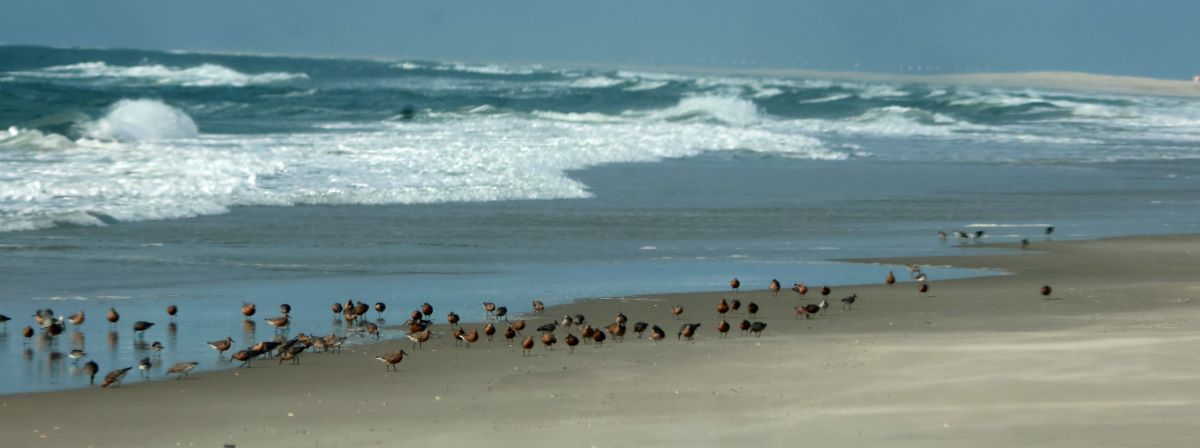
Reprinted from Ocracoke Observer
Those spending time on Ocracoke beach and other areas of the Outer Banks this spring may have been pleasantly surprised to see flocks of binge-foraging red knots, the rufa subspecies (Calidris canutus rufa).
Sponsor Spotlight
Transitioning from the drab basic or winter gray/white plumage to their bright orange/red breasts and rufous backs could make identification a challenge. But their behavior of feeding along the waterline in flocks from 10 or so to more than 100 distinguishes them from other shorebirds here.

The knots were using the beach as a foraging stopover, fattening up to make their long migration to their nesting grounds in the central Canadian Arctic.
Listed in 2014 as threatened under the Endangered Species Act of 1973, their presence in large numbers here and other areas added to a cautious sign of optimism that the species is doing better.
Historically, the Delaware Bay region has been considered the most important stopover for red knots’ long migration because that area coincides when horseshoe crabs arrive to spawn and lay millions of eggs. Horseshoe crab eggs are a high-fat, nutrient-rich food source and essential to fueling the Red Knots’ migration to their Arctic breeding grounds.
Sponsor Spotlight
An independent Delaware Bay survey in May reported 22,000 red knots, the highest number in four years. The lowest number tallied in these surveys was in 2021 with just 6,880. By contrast, the highest count was in 1989 with 90,000 individuals.
Another encouraging sign was aerial surveys taken in key Tierra del Fuego areas reported the highest number of wintering knots in 10 years. The southern tip of South America has been an important wintering ground. Those wintering individuals make one of the longest migrations — some 9,000 miles to nest and again return in the fall.
The two national seashores on the Outer Banks monitor red knots along with other species.
According to Amy Thompson, the biological science technician for Ocracoke, Cape Hatteras National Seashore collects red knot data a couple of different ways.
One of these methods is to systematically survey the entire island on the fifth, 15th and 25th of every month when weather conditions permit. The May 15 survey counted 1,318 individuals combined from the three districts of the Cape Hatteras National Seashore that include Bodie, Hatteras and Ocracoke islands, she wrote in an email.
“The other method is to collect opportunistic counts of Red Knots while we’re conducting morning patrols,” she added. “This provides a general idea of the total number of Red Knots stopping along the Seashore to rest and refuel on a daily basis. In the month of May, Ocracoke staff counted over 100 Red Knots every day with a minimum of 106 on May 1 and the maximum of 1,951 on May 10.”
The staff of Cape Lookout National Seashore, south of Ocracoke Islan, concluded their last red knot spring migration survey on June 5. Their surveys are divided into South Core Banks (SCB) and North Core Banks (NCB). The combined peak count was on May 15 with 1,986 individuals, according to Jon Altman, supervisory biologist for Cape Lookout National Seashore. “This number is lower than the high count of 2,997 birds last year on May 25, but overall, May 2023 had more birds the whole month than 2022,” he said in an email.
The combined total from nine surveys from March 15 to June 5 for Cape Lookout was 7,402 individuals.
“Unfortunately, we have not been able to cover from Ocracoke Inlet to Evergreen Inlet which is three miles of prime Red Knot habitat with little to no disturbance since it is hard to get to by boat and people can only walk that section.,” he said.
The red knot has a been a source of concern due to a rapid decline of its population, as much as a staggering 87% since 2000, according to a study, and more than 94% since the 1980s in some areas of the Atlantic Coast.
The principal cause for this decline is from a drastic decrease of horseshoe crab eggs which have plummeted due to the overharvesting of horseshoe crabs.

Of the 22,000 red knots observed, only 2,200 were seen on the Delaware side of the bay, the rest were in New Jersey. This is due, in part, to New Jersey having more protections for horseshoe crabs than Delaware, including a 2008 moratorium on harvesting, beach closures and habitat restoration projects.
The Carolina coasts are important foraging/resting stopovers for red knots as well as wintering grounds for them in small numbers.
The information gathered by the National Park Service along with aerial surveys adds to a better understanding of red knot migration and helps in making a recovery plan.
Taking active steps to help red knots increase their numbers will also benefit other species that make long distance migrations such as the ruddy turnstone and the semipalmated sandpiper.
There are many governmental agencies, conservation organizations, researchers and volunteers from Tierra del Fuego to the Arctic working to save the red knot. These efforts and limiting excessive harvesting of horseshoe crabs go hand in hand to removing them from the threatened list of the Endangered Species Act.
One website worth reading is A Rube with a View written by Larry Niles, Ph.D. He chronicled surveying the red knots presence in New Jersey this past spring.

This story is provided courtesy of the Ocracoke Observer, a newspaper covering Ocracoke island. Coastal Review is partnering with the Ocracoke Observer to provide readers with more environmental and lifestyle stories of interest along our coast.







